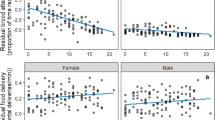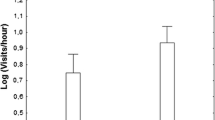Abstract
I studied the parental care behavior of the Madagascar paradise flycatcher Terpsiphone mutata in northwestern Madagascar. I especially focused on feeding, brooding and vigilance behaviors. Feeding rate did not differ between males and females, but females spent more time at the nest than males. Females dedicated their time to brooding, while males perched on the nest and were vigilant. Both parents changed the feeding rate in relation to brood size, so the feeding rate per nestling was not different among nests of different brood size. Duration of brooding by females increased with decreasing brood size, suggesting that the Royama effect, the pattern of lower feeding rate per nestling in larger broods, did not apply in this study. Males spent more time on vigilance than females. Anti-predator vigilance by males should be important for nestling survival given the high predation pressure typical of this population. In conclusion, males provide considerable parental care probably to minimize nestling starvation and to avoid nest predation. My results are not consistent with the general pattern of less parental effort by males in monogamous, sexually dimorphic species.




Similar content being viewed by others
References
Andersson M (1994) Sexual selection. Princeton University Press, Princeton
Best LB (1977) Nestling biology of the Field Sparrow. Auk 94:308–319
Björklund M (1990) A phylogenetic interaction of sexual dimorphism in body size and ornament in relation to mating system in birds. J Evol Biol 3:171–183
Breitwisch R, Merritt PG, Whitesides GH (1986) Parental investment by the Northern Mockingbird: male and female roles in feeding nestlings. Auk 103:152–159
Carere C, Alleva E (1998) Sex differences in parental care in the common swift (Apus apus): effect of brood size and nestling age. Can J Zool 76:1382–1387
Clutton-Brock TH (1991) The evolution of parental care. Princeton University Press, Princeton
Darwin C (1871) The descent of man, and selection in relation to sex. Murray, London
Dunn PO, Whittingham LA, Pitcher TE (2001) Mating systems, sperm competition, and the evolution of sexual dimorphism in birds. Evolution 55:161–175
Filliater TS, Breitwitch R (1997) Nestling provisioning by the extremely dichromatic Northern Cardinal. Wilson Bull 109:145–153
Goodman SM, Parrillo P (1997) A study of the diets of malagasy birds based on stomach contents. Ostrich 68:104–113
Hails CJ (1979) A comparison of flight energetics in Hirundinidae and other birds. Comp Biochem Physiol A 63:581–585
Hino T (1998) Mutualistic and commensal organization of avian mixed-species foraging flocks in a forest of western Madagascar. J Avian Biol 29:17–24
Johnson EJ, Best LB (1982) Factors affecting feeding and brooding of Gray Catbird nestlings. Auk 99:148–156
Kirkpatrick M, Price T, Arnold SJ (1990) The Darwin–Fisher theory of sexual selection in monogamous birds. Evolution 44:180–193
Knapton RW (1984) Parental feeding of nestling Nashville Warblers: the effects of food type, brood size, nestling age, and time of day. Wilson Bull 96:594–602
Lack D (1968) Ecological adaptations for breeding in birds. Methuen, London
Langrand O (1990) Guide to the birds of Madagascar. Yale University Press, London
Lazarus J, Inglis IR (1986) Shared and unshared parental investment, parent–offspring conflict and brood size. Anim Behav 34:1791–1804
Leffelaar D, Robertson RJ (1986) Equality of feeding roles and the maintenance of monogamy in tree swallows. Behav Ecol Sociobiol 18:199–206
Ligon JD (1999) The evolution of avian breeding systems. Oxford University Press, Oxford
Mizuta T (1998) The breeding biology of the black paradise flycatcher Terpsiphone atrocaudata. Jpn J Ornithol 47:25–28
Mizuta T (2000) Intrusion into neighboring home range by male Madagascar paradise flycatchers Terpsiphone mutata: a circumstantial evidence for extra-pair copulation. J Ethol 18:123–126
Mizuta T (2002a) Seasonal changes in egg mass and timing of laying in the Madagascar paradise flycatcher, Terpsiphone mutata. Ostrich 73:5–10
Mizuta T (2002b) Breeding biology of the Madagascar paradise flycatcher Terpsiphone mutata, with special reference to plumage variation in males. Ostrich 73:67–69
Mizuta T (2002c) Predation by Eulemur fulvus fulvus on a nestling of Terpsiphone mutata (Aves: Monarchidae) in dry forest in northwestern Madagascar. Folia Primatol 73:217–219
Mizuta T, Yamagishi S (1998) Breeding biology of monogamous Asian paradise flycatcher Terpsiphone paradisi (Aves: Monarchinae): a special reference to color dimorphism and exaggerated long tails in male. Raffles Bull Zool 46:101–112
Møller AP (1986) Mating systems among European passerines: a review. Ibis 128:234–250
Møller AP, Birkhead TR (1993) Certainty of paternity covaries with parental care in birds. Behav Ecol Sociobiol 33:261–268
Møller AP, Birkhead TR (1994) The evolution of plumage brightness in birds is related to extrapair paternity. Evolution 48:1089–1100
Møller AP, Thornhill R (1998) Male parental care, differential parental investment by females and sexual selection. Anim Behav 55:1507–1515
Moreau RE (1947) Relations between number in brood, feeding-rate and nestling period in nine species of birds in Tanganyka Territory. J Anim Ecol 16:205–209
Mulder RA, Ramiarison R (2003) Terpsiphone mutata, Madagascar paradise flycatcher, Remaly, Tsingetra, Rengetra, Singetraka, Dady, Angetry. In: Goodman SM, Benstead JP (eds) The natural history of Madagascar. University of Chicago Press, Chicago, pp 1134–1146
Nur N (1984) Feeding frequencies of nestling blue tits (Parus caeruleus): costs, benefits and a model of optimal feeding frequency. Oecologia 65:125–137
Owens IPF, Hartley IR (1998) Sexual dimorphism in birds: why are there so many different forms of dimorphism? Proc R Soc London B 265:397–407
Rosa SM, Murphy MT (1994) Trade-offs and constraints on Eastern Kingbird parental care. Wilson Bull 106:668–678
Royama T (1966) Factors governing feeding rate, food requirement and brood size of Great Tits Parus major. Ibis 108:313–347
Rytkönen S, Koivula K, Orell M (1996) Patterns of per-brood and per-offspring provisioning efforts in the Willow Tit Parus montanus. J Avian Biol 27:21–30
Schadd CA, Ritchison G (1998) Provisioning of nestlings by male and female Yellow-breasted Chats. Wilson Bull 110:398–402
Sinclair I, Langrand O (1998) Birds of the Indian Ocean islands. Struik, Cape Town
Sokal RR, Rohlf FJ (1995) Biometry. W.H. Freeman, New York
Trémont S, Ford HA (2000) Partitioning of parental care in the Leaden Flycatcher. Emu 100:1–11
Verner J, Willson MF (1969) Mating systems, sexual dimorphism, and the role of male North American passerine birds in the nesting cycle. Ornithol Monogr 9:1–76
Westneat DF (1988) Male parental care and extrapair copulations in the Indigo Bunting. Auk 105:149–160
Williams JB (1988) Field metabolism of tree swallows during the breeding season. Auk 105:706–714
Winkler DW (1987) A general model for parental care. Am Nat 130:526–543
Woodard JD, Murphy MT (1999) Sex roles, parental experience and reproductive success of eastern kingbirds, Tyrannus tyrannus. Anim Behav 57:105–115
Yasukawa K, McClure JL, Boley RA, Zanocco J (1990) Provisioning of nestlings by male and female red-winged blackbirds, Agelaius phoeniceus. Anim Behav 40:153–166
Acknowledgments
I am grateful to Dr. Satoshi Yamagishi and the members of the Madagascar Ornithological and Herpetological Research Team for their valuable criticisms of this study. I am also indebted to the Director, Albert Randrianjafy, and other staff of Parc Botanique et Zoologique de Tsimbazaza for their cooperation. Hearty thanks go to the staff of ANGAP for providing accommodation and facilities at Ampijoroa Forest Station. Dr. Alan Savitzky kindly checked English usage in an early draft. This study was supported by a grant under the Monbusho International Scientific Research Program (Field Research, Nos. 01041079 and 06041093) and the JSPS Research Fellowships for Young Scientists.
Author information
Authors and Affiliations
Corresponding author
About this article
Cite this article
Mizuta, T. Parental care behavior in the monogamous, sexually dimorphic Madagascar paradise flycatcher: sex differences and the effect of brood size. Ecol Res 20, 547–553 (2005). https://doi.org/10.1007/s11284-005-0066-5
Received:
Accepted:
Published:
Issue Date:
DOI: https://doi.org/10.1007/s11284-005-0066-5




